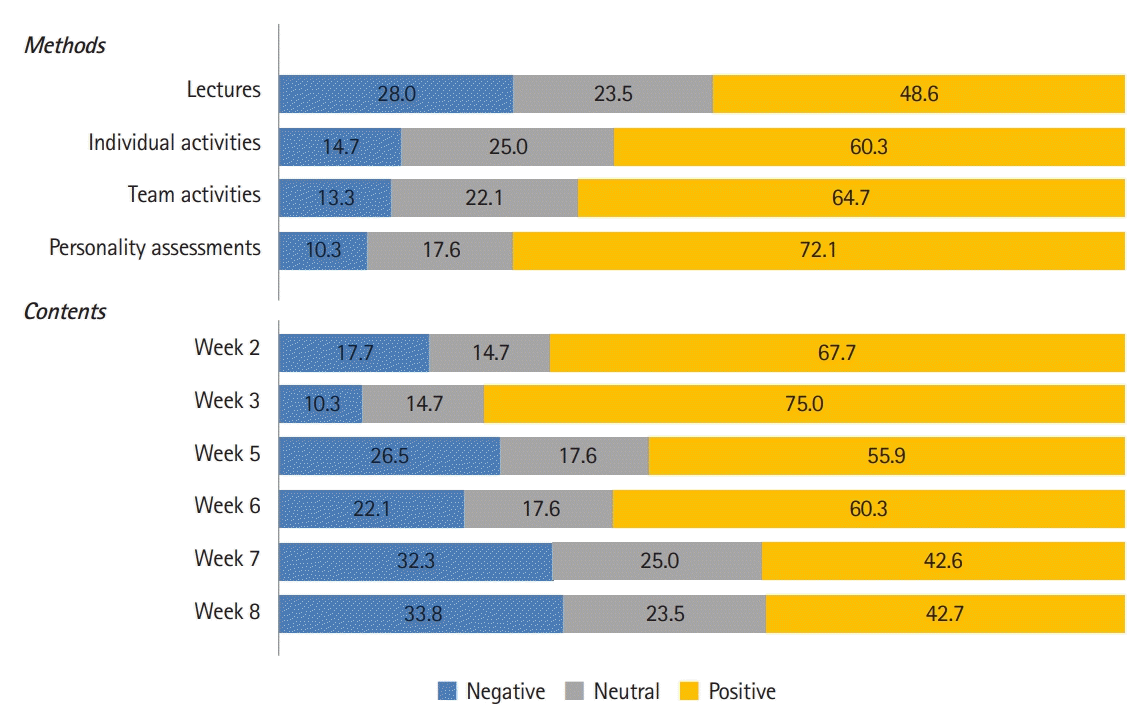Key results
We developed and operated a portfolio-based course to improve pre-medical students’ self-management and self-improvement ability. Although 71.2% of students replied that they worked hard and took creation of their portfolios seriously, only 6.2% among them earned a grade of A. However, 54.9% of the students responded that their portfolio creation experience helped them to reflect on and plan the rest of their university life and even their subsequent life as a doctor, confirming its educational value.
Interpretation and suggestion
In order to achieve better outcomes, the following aspects were identified as needing improvement in terms of portfolio management methods, curriculum and educational methods, and the process of portfolio creation:
First, only a small percentage of students received a grade of A. Most students lacked an understanding of the concepts underlying a portfolio, the meaning of a portfolio, and how to utilize them, and their portfolios often lacked basic components. Therefore, although providing autonomy for portfolio creation is necessary, it might also be effective to provide standard samples, specific guidelines, and various worksheets. In addition, developing pre-training and giving specific feedback on utilizing portfolios will help students gain an accurate understanding of the concepts underlying portfolios and the meaning of a portfolio.
Second, it is necessary to improve the curriculum and educational methods. Pre-medical students are adult learners. As many students indicated, they are likely to already have established personal approaches to concepts related to self-directed college life (e.g., learning strategies and time management), self-leadership, and self-identity. Therefore, it may be redundant for the instructor to spend time lecturing about this content, and it would be better to allot more time for portfolio creation instead. Negative evaluations by students tended to increase as the semester progressed, which implies that portfolio creation may require a considerable amount of time and that the workload may cause fatigue. Correspondingly, 42.5% of the students replied that portfolio creation interfered with their other studies, and similar opinions were given in replies to the open-ended question. This problem can be solved by reducing the amount of lecture time and allotting time for autonomous portfolio creation within the regular classes.
Third, portfolio-based courses should be implemented in small-group or one-on-one settings, as 84.8% of the students responded that it would be appropriate for the course to be administered to small groups. Considering that this course focuses on individual reflection and self-improvement, making it necessary to implement a form of process-oriented education, it is inevitably difficult to maximize the value of education in large groups. However, if small groups or a one-to-one setting is adopted, the number of instructors needed will increase, because it will be necessary to deliver the course to different groups at the same time. Therefore, any university program interested in trying portfolio-based education should secure sufficient manpower through instructor training. Additionally, it is necessary to develop and standardize portfolio forms, the writing process, evaluation criteria, and feedback items to ensure the quality of the entire educational process and how it is evaluated.
Comparison with previous studies
It is only recently that portfolios have been introduced into undergraduate education, and there are not enough previous studies on the introduction of the portfolio concept into pre-medical courses in other countries. In addition, the use of different measurement tools makes it difficult to make direct comparisons. Nevertheless, previous studies have reported that portfolios are seen as increasingly valuable in medical education, and that the systemic use of portfolios increases students’ reflections on their own experiences and professional competence. In addition to students’ learning, we anticipate that portfolios will support their educational achievements. For example, in Saudi Arabia, the portfolio method was implemented for medical students, and self-assessment of the skills learned through this process was conducted. Evidence was found that this process was valued positively and that portfolio-based learning may be becoming more accepted by students [
7]. Web-based electronic portfolio creation was implemented for Spanish medical students to evaluate their knowledge of manual skills and surgical techniques. The students stated that portfolio creation was useful when the workload and complexity of learning objectives were adequate, and that the electronic portfolio helped them to set directions for their learning [
8]. In the United Kingdom, electronic portfolio creation for medical students was implemented and a qualitative analysis was performed on the usefulness of this process based on students’ opinions obtained through free writing. Students showed interest in 5 aspects: the objectives of portfolio creation, usage, acceptance, strengths and limitations of portfolio utilization, and the impact of portfolios on professional identity and learning. Portfolios also had a positive influence on understanding one’s identity [
9]. Lund University, in Sweden, has implemented a portfolio of standardized general practice guidelines for senior medical students. The standardized portfolio provided ample opportunities for experts to evaluate students’ professionalism, and support from mentors and examiner interviews contributed to students’ proper implementation of the portfolio [
10].
Limitation
It is difficult to generalize the results of this study, which is based only on the experiences of a single medical school. In addition, since the course was offered for only 1 semester, the effectiveness of the curriculum could not be verified objectively.
Conclusion
Despite the limitations of this study, students’ perceptions and experiences provided important insights into the value of this portfolio-based course. Therefore, this study is meaningful in that the value and possibility of a portfolio-based course was confirmed through students’ evaluations. In addition, basic principles for developing a specific curriculum and educational methods were proposed. If the course is revamped based on this study, if mid- and long-term operational experience is gathered in subsequent years, and if students become habituated to portfolio creation, future research would yield more meaningful insights into its educational effects.

